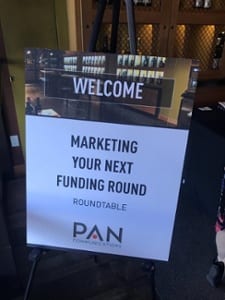PAN Communications recently hosted a roundtable in San Francisco featuring four panelists: Ty Shay, CMO at Norton and Lifelock; Don Clark, Wall Street Journal; J.P. Whelan, General Partner at Kern Whelan Capital; and David Petersen, startup advisor and former CEO of Sense Networks. The topic of discussion was “Marketing Your Next Round of Funding,” and there were several key takeaways from the session that emerging businesses can use to help market their next funding round in an effective way.
 Below are the top six questions emerging businesses should ask before planning their next funding round.
Below are the top six questions emerging businesses should ask before planning their next funding round.
1) What’s the goal of the funding announcement?
Determining the goal of the announcement is a critical first step, as you will need to communicate this to the media. Is the funding for new product development, hiring, attracting new customers or partners, revenue growth or for new market entry? You need to underscore what this funding announcement is really about and then apply your time and energy accordingly. After you solidify your primary goal, your team should discuss secondary goals. What else do you want to relay to the media and your audiences at this time? Be strategic in your approach and make sure that your secondary points are related to your recent funding round and your company’s growth strategy. Funding announcements often gain good traction, so make the most of this opportunity.
2) Should I issue a press release?
There was some debate when it came to whether or not a company should issue a press release. Several factors come into play when making this decision: 1) If your product is still in stealth mode, then the recommendation is not to issue a press release; 2) Don’t issue a press release just for the sake of doing so. Make sure that it includes valuable content; 3) Solidifying media interest and coverage should be a primary goal when issuing a funding press release. If you don’t think that your news will be picked up by the right media channels, then you will just end up broadcasting your own news, which is not ideal. Publishing information on your website is informative, but third-party credibility can take you much further.
“Investors will look at your PR stream to get a sense of your company’s DNA. Most importantly is what you have actually executed on in terms of your announcements and press releases. Don’t go and talk about some great channel partnership if you don’t think it will bear any fruit. Because I can guarantee you that’s one of the first things I’m going to ask you about when I meet with you.” – J.P. Whelan, General Partner at Kern Whelan Capital
3) Are Kickstarters automatically dismissed by the press?
Some of the greatest stories are the Kickstarter stories because they have a dynamic narrative. If you have a small funding round but an amazing story that’s different from the rest of your market, you can attract media to this development and have them invest emotionally in your company’s story. Don’t try and reach for perfection within your first round. If your company has pain points, then it makes the story more relatable and captivating to your audience and then to media. It doesn’t always have to be the VentureBeat’s or the TechCrunch’s of the world that pick up your funding announcement. Your story can have an even bigger impact via industry publications because you’re reaching a narrower audience.
“I think some of the greater stories are the Kickstarter stories. People who have rounds and small goals that blow through it – I think that’s a good narrative and a good story that spreads. If you can have a small round with an industry specialist, it might not even be a bencher, but maybe you tack on an expert that invests their own money, I think those are some of the ways you can differentiate your story, at least within certain pockets.” – Ty Shay, CMO at Norton and Lifelock
4) Should I offer an exclusive?
When you offer an exclusive, you are potentially sacrificing other media relationships. It’s really in your best interest to not offer an exclusive unless you know that your audience is only reading one publication – which is highly unlikely. If your product is extremely obscure, an exclusive can be a valid option. But, in general, instead of offering exclusives, you should be building relationships with and briefing reporters. You can then reach out to those journalists down the line when you want to position your executives as thought leaders and get into the right publications with future funding or product announcements.
5) How can I further market and amplify my funding round?
CEOs at emerging growth companies get excited when VC influencers express an interest in funding rounds on social media. Some have been known to be more thrilled by one tweet than by an entire article in a prevalent publication. Make sure that you are getting your announcements in front of the right eyes on social media. If you have a list of influencers, then reach out to them via social. Share not only your press release but also your coverage and remember to engage with people that are sharing your funding announcement.
“If you can get your story into the VC Twitter community channel, you end up getting that reach that you’re looking for as well as that credibility. I think it’s hard to do and you need an exceptional team and an exceptional idea to really pull it off and get those results.” – David Petersen, start-up advisor and former CEO of Sense Networks

6) How can my company tell the right story?
This is where your PR team can get involved and simplify the story, make it intriguing and articulate it so that every reporter understands why this product or service just got funded. If the story is told correctly, the media should understand how this would change their day-to-day life in a positive way. Even if you are talking about B2B tech, there is still a way to tell that story and tie it back to something relatable. Your PR team should be fully equipped to tell your company’s story in a way that’s accurate so that their efforts will lead to opportunity. Make sure they aren’t talking about some channel partnership to the media if it’s not at all important to your company’s story or growth efforts. Your true story lies in what makes your company unique – Is your company defying the odds by going up against a giant tech company? Is your company revolutionizing older technology? Is your company first to market? If you focus at an atomic level it’s a lot easier to differentiate yourself from other solutions. For example, if you’re walking through a tradeshow and you see five booths that basically have the same sort of product, it’s hard to really figure out why they’re different. But, if your company is promoting the specific problem that it’s solving then that’s a very good way to start engaging.
“Have a good story. Before you try and tell it, just have a good story. More on the tactical rules of the road when you are dealing with journalists – just be nice. It’s easy to needlessly annoy people in the press. A lot of the good press coverage is boiled down to someone knowing somebody else and knowing that journalist was interested in that specific area, or there was a personal relationship with the CEO. All these things that aren’t quantifiable or systematic, so just be kind.” – Don Clark, Wall Street Journal

At the end of the day, it’s not just about the press release. Think about using this announcement to build media relationships, tell your company’s story and reach out to influencers and customers to build that advocacy and support.
A special thanks to our panelists and everyone that attended our roundtable event. We look forward to hosting future San Francisco events!
Do you have other tips for marketing funding rounds? Share your ideas @PANcomm.


